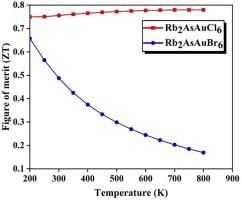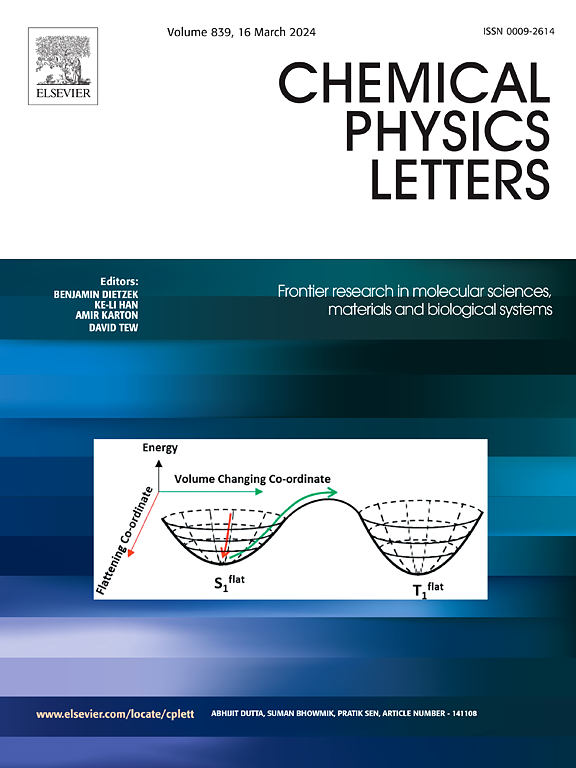用于能量收集应用的 Rb2AsAuX6(X = Cl、Br)卤化物双包晶的电子传输特性
IF 2.8
3区 化学
Q3 CHEMISTRY, PHYSICAL
引用次数: 0
摘要
在此,我们利用密度泛函理论(DFT)计算研究了两种窄带隙卤化物双包晶石(HDPs)Rb2AsAuX6(X = Cl、Br)的物理特性。这两种化合物都表现出热力学稳定性,具有非磁性基态和稳定的立方对称性,并得到了几何优化、公差因子标准和负形成焓的支持。电子结构分析表明,Rb2AsAuCl6 和 Rb2AsAuBr6 具有半导体行为,带隙分别为 0.66 和 0.07 eV,这主要归因于费米级附近 As 和 Au 状态之间的相互作用。除了低反射率(小于 10%)和高导电率之外,光学研究还突出了可见光谱中的显著吸收和红外(IR)区域的起始边缘,这使得这两种 HDPs 成为光电器件广泛应用的潜在竞争者。热电分析表明,在室温下,Rb2AsAuCl6 和 Rb2AsAuBr6 的热电效率分别接近 0.8 和 0.5。研究结果表明,Rb2AsAuCl6 和 Rb2AsAuBr6 具有独特的结构稳定性、可调带隙和高效热电性能,有望用于未来的光电和热电应用领域。本文章由计算机程序翻译,如有差异,请以英文原文为准。

Electronic transport properties of Rb2AsAuX6 (X = Cl, Br) halide double perovskites for energy harvesting applications
Herein, we investigated the physical characteristics of two narrow band gap halide double perovskites (HDPs) Rb2AsAuX6 (X = Cl, Br) by using density functional theory (DFT) calculations. Both compounds exhibit thermodynamical stability with non-magnetic ground states and stable cubic symmetry supported by geometry optimization, tolerance factor criteria, and negative formation enthalpies. The electronic structure analysis reveals semiconducting behavior, with bandgaps of 0.66 for Rb2AsAuCl6 and 0.07 eV for Rb2AsAuBr6, attributed primarily to the interaction between As and Au states near the Fermi level. Optical investigations highlight significant absorption in the visible spectrum with onset edges in the infrared (IR) region in addition to low reflectivity (less than 10 %) and high conductivity makes both HDPs potential contender for optoelectronic device applications across a broad spectrum. The thermoelectric analysis reveals promising efficiency, with figure of merit (ZT) values approaching ∼0.8 for Rb2AsAuCl6 and ∼0.5 for Rb2AsAuBr6 at room temperature. The results indicate that Rb2AsAuCl6 and Rb2AsAuBr6 have the potential to be used in future optoelectronic and thermoelectric applications due to their unique combination of structural stability, tunable bandgaps, and efficient thermoelectric performance.
求助全文
通过发布文献求助,成功后即可免费获取论文全文。
去求助
来源期刊

Chemical Physics Letters
化学-物理:原子、分子和化学物理
CiteScore
5.70
自引率
3.60%
发文量
798
审稿时长
33 days
期刊介绍:
Chemical Physics Letters has an open access mirror journal, Chemical Physics Letters: X, sharing the same aims and scope, editorial team, submission system and rigorous peer review.
Chemical Physics Letters publishes brief reports on molecules, interfaces, condensed phases, nanomaterials and nanostructures, polymers, biomolecular systems, and energy conversion and storage.
Criteria for publication are quality, urgency and impact. Further, experimental results reported in the journal have direct relevance for theory, and theoretical developments or non-routine computations relate directly to experiment. Manuscripts must satisfy these criteria and should not be minor extensions of previous work.
 求助内容:
求助内容: 应助结果提醒方式:
应助结果提醒方式:


